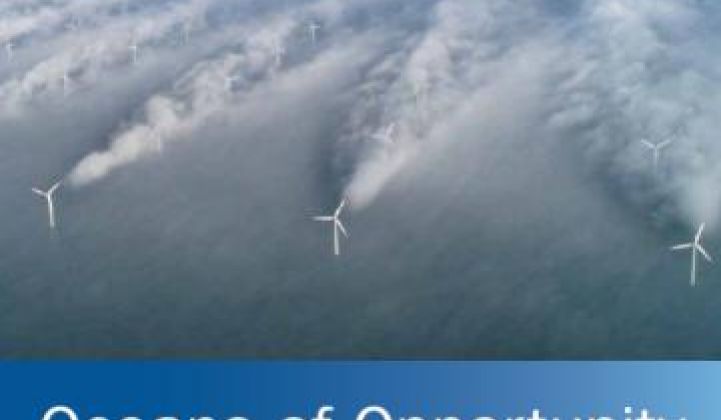The cost of harvesting offshore wind energy may be a lot lower than the early numbers from controversial projects suggest.
There are “almost 4,000 gigawatts of capacity within 50 nautical miles of U.S. coasts,” said Dr. Habib J. Dagher, Director of both the Composite Center and the U.S. Department of Energy (DOE)-funded DeepC Wind Consortium at the University of Maine, “and the total U.S. electricity capacity is around 1,000 gigawatts.”
It is, Dagher said, “the largest single opportunity we have in renewable energy.” And, he added, “the majority of our population lives in the coastal states and has access to this resource.”
The real question, however, is whether the resource can be harvested competitively. Dagher says his research consortium’s findings suggest it can if it is done right.
“It’s unfortunate,” Dagher said, discussing the small Block Island shallow water offshore wind project off Rhode Island and the controversial Cape Wind offshore project off Massachusetts, “that people say that’s the price of offshore wind.”
The five-to-eight-turbine Block Island’s power purchase agreement (PPA), currently under legal challenge, is priced at 24.4 cents per kilowatt-hour. The 130-turbine Cape Wind’s PPA is priced at 18.7 cents per kilowatt-hour. The average price of electricity in New England vacillates in the 15 to 17 cents per kilowatt-hour range.
The cost of electricity from those emerging offshore projects is, Dagher said, very expensive because they have “large uncertainties and a large learning curve. Those costs do not truly reflect where this industry will be in ten years if we scale up the industry properly.” They are, he added, “pioneering projects.”
“Deep offshore wind and shallow or medium depth offshore wind are completely different technologies,” Dagher explained of the DeepC Consortium’s thrust. “The basic difference is the cost of construction offshore.”
Europe has built more than 20 shallow and medium-depth projects using heavy equipment to put turbines and other infrastructure in place. "The jack-up barges and cranes will cost you $150,000 to $200,000 a day to run. Building offshore is very costly. And there is the cost of capital, as well,” Dagher said. “The more building you do in the water, the more the capital costs go up.”
Dagher and his group want to build floating turbines that can be towed out to sea and anchored, eliminating the costs and risks of construction. “Our approach is to do as much as we can on land, pre-assemble these units, and do very little in the water. That’s how we’re going to save money.”
Funded by DOE after being chosen in open competition, Dagher’s DeepC Consortium has evaluated fourteen proprietary floating turbine proposals and selected six to study in detail. Careful comparisons indicate that five-megawatt floating turbines will require no more “material costs” than fixed turbines, but will eliminate the costs of ocean construction.
According to turbine manufacturers’ rule-of-thumb, Dagher said, “If you’re going to build something on land and it’s going to cost you a dollar, if you’re going to build it at quay-side, it might cost you three or four dollars and if you’re going to go out and build it twenty miles offshore, it might cost you six to ten dollars.”
Instead of “being at the mercy of the elements” in the “two or three months of the year you can do this kind of work” and paying hundreds of thousands of dollars in barge and crane costs, a quay-side-built, five-megawatt floating turbine can be towed twenty miles offshore with a twenty-ton tugboat in ten hours.
Using this strategy, Dagher’s group has concluded, offshore wind-generated electricity can almost match the price of electricity consumers are now paying, exclusive of the costs for delivering it. “Half of the price is transmission and distribution, the other half is generating electrons,” Dagher said. “If I’m paying sixteen cents, eight cents is used to make the electrons.”
The goal of Dagher’s consortium is to get the cost of generation “to ten cents per kilowatt-hour, plugged into the grid, by 2020, if we scale up to a thousand megawatts.”
The crucial assumption, he stipulated, is that the industry matures enough by 2020 to the point where it achieves the capacity to build 1,000-megawatt projects. At that size, economies of scale will make it possible to build floating wind farms at costs that will meet the ten cents goal.
That goal includes the cost of transmitting the electricity generated at sea to the grid, a cost that will be considerable for early and small projects like Block Island and Cape Wind. When projects such as the Google-led Atlantic Wind Development consortium’s Atlantic Wind Connection transmission backbone are in place off the coasts, the costs of getting electricity to the grid will go down.
“Transmission and distribution is a key barrier,” Dagher said. “I think it’s a critical project.” Separating the building of transmission from the building of the wind farm “takes a huge load off the investors, the developers and the capital.”
One other thing is needed, however. “Everything starts with government policy,” Dagher said. "The U.S. needs a goal, a target,” he insisted. “Industry is ready to move but they need a stable policy.” And the policy, he added, must have incentives that ease the burden of taking on the enormous risks of entirely new and unproven technologies -- like floating wind turbines.



